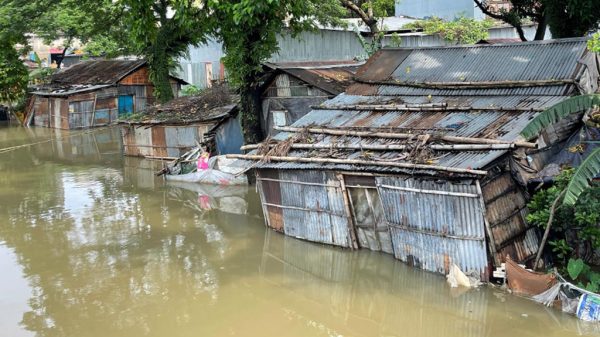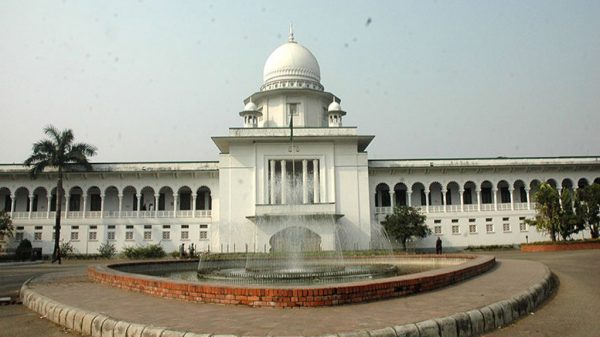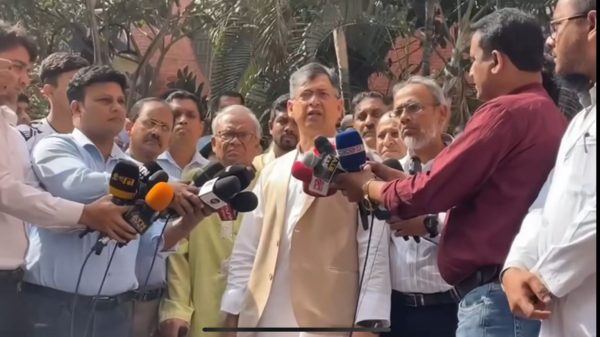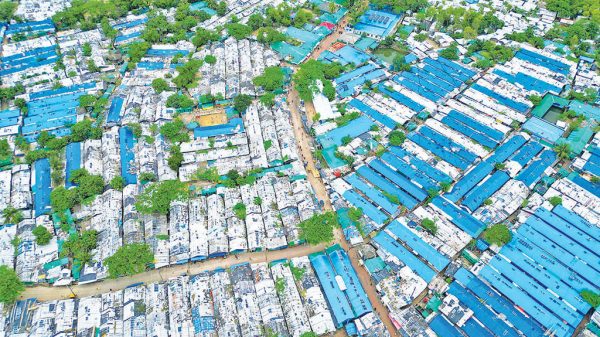Flash flood affects 50 lakh people in 10 dists

Shawdesh Desk:
The ongoing flash flood that swept vast swathes of northern and north-eastern regions for the ninth day running on Saturday affected more than 50 lakh people, official estimates showed.
Nearly 70,000 people, children and elders among them, along with their cattle, passed yet another day huddling in several thousand temporary flood shelters opened in educational institutions and government offices in the affected 10 districts.
On Saturday, eight major rivers flowed above their danger marks at 9:00am, the last hour of the 24-hour reporting cycle, as they continued to fall up to 40cm over the reporting period.
Sylhet is particularly the worst hit district since it was already swept by two waves of flash flood since May 28 after cyclonic storm Remal made landfall, bringing record amounts of rain.
The onset of monsoon this year was ranked as the third earliest in four decades amidst forecast of above-normal rainfall occurring in the four-month season ending in September.
‘Many people are going home as flood started retreating,’ said Sylhet divisional commissioner Abu Ahmad Siddiqui who visited flood affected areas in Moulvibazar on Saturday.
New Age correspondent in Moulvibazar reported that floodwater washed away a 10-year-old boy, Limon Miah, in sadar upazila in the afternoon.
‘It will take time to return home which is now covered by mud,’ said Salamat Bibi who took shelter at a government school along with 30 families.
The Juri River at Juri point flowed 193cm above the danger mark on Saturday morning, reported New Age correspondent in Moulvibazar.
The flood in Moulvibazar was triggered by heavy rain over vast hilly areas in the upstream.
The latest spell of flash flood hit Sylhet on June 15, the day 15 rivers were above their danger levels in Sylhet, Sunamganj, Habiganj, Moulvibazar and Netrokona districts.
The Khowai River swelled 433cm above its danger mark on June 15, followed by the Dhalai flowing 394cm above the danger mark.
The flood situation in Sylhet improved as rainfall declined. In the middle of the month, vast swathes from Himalayas to north-eastern Bangladesh received up to 600mm of rainfall in 24 hours for several days in a row.
The office of Sylhet divisional commissioner said that the ongoing flood left 21,60,968 people stranded, nearly half of them in Sylhet.
Sylhet encountered two waves of flash flood since the onset of monsoon. The first spell lasted more than a week affecting 10 lakh people. The Sylhet City Corporation went under water at least thrice.
Many people in 30 wards out 42 in the city corporation went to their relatives or shelters fleeing flood that ruined the joy of Eid-ul-Azha, reported New Age correspondent in Sylhet.
This year is reminiscent of 2022, when back to back floods in June created a humanitarian crisis in north-east Bangladesh, particularly in Sylhet and Sunamganj districts completely engulfed in water.
The problem is far from over as the monsoon has about three and a half months to go.
The rain that was once blessing, providing irrigation for year’s most productive time, turned out to be a curse.
Siltation lifted riverbeds with the river channels narrowed down through encroachments, reducing the passage for onrush of water from the world’s one of the wettest regions, Cherrapunji. An inevitable consequence of flood is water stagnation, especially in cities and towns.
Sylhet city mayor Anwaruzzaman Chowdhury, while visiting flood affected areas on Saturday, recognised the need to free rivers from encroachment to get rid of water stagnation.
The flash flood inundated vast swathes of agricultural land and washed away and damaged infrastructure.
New Age correspondent in Lalmonirhat reported the death of a 63-year-old man, Abu Aslam, a resident of Tepa Madhupur of Kaunia upazila in Rangpur, being crushed under his house as he was relocating it trying to escape from erosion.
The Water Development Board local office said that 43 houses were lost in erosion between Friday and Saturday in Rangpur, Lalmonirhat, Gaibandha, Kurigram and Nilphamari districts.
A body was also recovered on Saturday morning.
At least 35,000 people are stranded in the five flood affected northern districts.
The Flood Forecasting and Warning Centre in its daily bulletin issued on Saturday afternoon showed that the Teesta, Surma, Kushiyara, Puraton Surma and Someswari were flowing above the danger marks at seven points.
The water levels in the Teesta, Dharla and Dudhkumar might drop briefly before rising again caused by potential rainfall in Bangladesh’s northern region and its upstream over the next 72 hours, said the FFWC bulletin.
The Ganges and the Jamuna were also on the rising trend.
The Bangladesh Meteorological Department in a bulletin issued at 6:00pm on Saturday for 24 hours said that light to moderate rain accompanied by temporary gusty wind is likely to occur at most places over Rangpur, Mymensingh and Sylhet divisions, at a few places in Chattogram division and at one or two places over Rajshahi, Dhaka, Khulna and Barishal divisions.
Bangladesh’s highest rainfall of 108mm in the 24 hours ending at 6:00pm on Saturday was recorded in Tangail, the BMD said.
The BMD predicted increased rainfall at the end of the week.























Leave a Reply